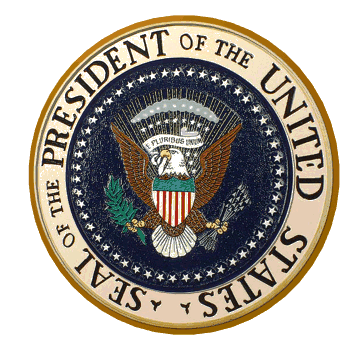 TheUSAPresidents.com
TheUSAPresidents.com 
 TheUSAPresidents.com
TheUSAPresidents.com 
 We have pages on every president!
We have pages on every president!
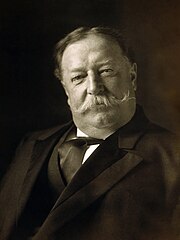
https://www.loc.gov/resource/cph.3f06279/, Public domain, via Wikimedia Commons
← T. Roosevelt | Woodrow Wilson →
Term Dates
March 4, 1909 - March 4, 1913
William Howard Taft was a politician who served as the 27th president of the United States of America. He was encouraged to run by Theodore Roosevelt in the 1908 election even though many others would have rather had Roosevelt just run for another term. However, Taft ended up winning. While Taft was expected to simply carry on Roosevelt's policies, he instead started to do other things and didn't place many Roosevelt policies as a priority. Because of this, in the 1912 election, Roosevelt ran again, splitting the Republican party and making Taft suffer one of the worst defeats of a sitting president in history. After the presidency, Taft was able to lose a lot of weight as he was the most obese president in history, and became the only former president to become a Supreme Court Justice.
Taft was born on September 15, 1857 in Cincinatti, Ohio to Alphonso Taft and Louise Torrey. His father, Alphonso, was a pretty notable person who served as the Secretary of War and Attorney General for Ulysses Grant. Despite this, the Tafts were not that rich, living in a small suburb. While the Taft parents tried their best to make their kids successful, young William was not that smart. However, he was a very hard worker. At Yale College, William Howard Taft was a wrestling champion. A secret society in Yale called "Skull and Bones" was co-founded by Taft's father, prompting wrestling superstar William to join the club. Apparently, George H. W. Bush and George W. Bush were also in this secret society. (This is legitimately the coolest thing I've ever found about a president.) Even though William used to be not that bright, by 1878 he had graduated second in his college class out of 121 students. He then attended Cincinnati Law School (I guess he ditched wrestling) and graduated with a Bachelors' degree in 1880. He later passed the bar exam.
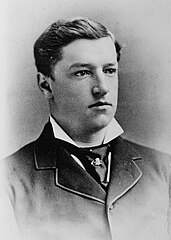
Taft was appointed as Hamilton County's assistant prosecutor in October 1880. When president Chester Arthur appointed Taft as a Collector of Internal Revenue for Ohio's first district in 1882, Taft resigned. He resigned from his Internal Revenue Collector job in 1883. In 1884, Taft campaigned for James Blaine in the 1884 election. In 1887, Taft was suddenly hired to fulfill a vacancy for a position in Cincinnatti's Superior Court, and in 1888 won his first ever public election to serve for another five years. Sometime in 1880 or before, Taft met Helen Herron, who would later be his first lady. She agreed to marry Taft in 1885 after regularly meeting him the year prior. They officially got married on June 19, 1886. They would have three children, with Robert Taft becoming a notable U.S. Senator. In 1889, a vacancy in the Supreme Court needed to be filled by president Benjamin Harrison. Joseph Foraker, a governor of Ohio, had requested that Harrison nominate Taft for the position. Though the Supreme Court was Taft's goal, Harrison ended up nominating Taft as the Solicitor General instead. Since the position was vacant, a lot of work needed to be done. He started in February 1890. Even though Taft was good at his job, he gladly resigned in March 1892 to be a judge on the sixth circuit of the United States Courts of Appeal. Unlike his previous judge job, this job was a position of his for life (well, unless he resigned or was impeached). Taft, during this period, felt great with his life and his job. Taft was a man who supported employees over employers, as seen by his many Worker's Rights cases. He was more liberal than people had thought. Taft became a professor at Cincinnati Law School in 1896 and was committed to it. Also in 1896, William McKinley sought the presidency. Taft was not fond of McKinley and disagreed with things like Free Silver. In 1898, one year into McKinley's presidency, Taft was upset because McKinley named a different person than Taft to be a Supreme Court Judge.
Though Taft did not like McKinley, he was called into Washington by him in January 1900. McKinley asked Taft to be a part of a committee focused on creating a civilian government in the Philippines. McKinley offered to guarantee that if Taft agreed, he would appoint him to the vacancy on the Supreme Court. Taft agreed, but only after saying that he must be the head of the commission. Taft traveled to the Philippines in April, and became the civilian general on Independence Day in 1901. He accepted the Philippines' surrender in 1902 and allowed the use of concentration camps. When testifying, he did not mention the camps but did say the military was committing some offenses. Taft treated the citizens as equal and did not enforce segregation laws. In 1901 President McKinley was assassinated and Taft's friend whom he had met in 1890, Theodore Roosevelt, became president. Taft could have become a judge on the Supreme Court in 1902, but he refused because he didn't feel he was done with his job as governor. Taft finished that job and returned to the United States in 1903, becoming Secretary of War in January 1904. Though he was Secretary of War, he didn't do as much as President Roosevelt did a lot of it. Taft was more of a second in command with military decisions, and it became more and more apparent that Roosevelt wanted Taft to be the Republican nominee in the 1908 election. Though he would end up regretting it, Roosevelt said he would not run for re-election in 1908. A reluctant Taft finally agreed to be endorsed by Roosevelt, and Roosevelt said that his appointees needed to either endorse Taft or be quiet, or else they'd be fired. (Dang, c'mon Roosevelt.) The Republican nomination for Taft was not that hard to get. Roosevelt's influence (and perhaps ego) made sure no one else ran. Not even Taft's running mate was someone he liked, being James Sherman, a conservative. On June 30, 1908, Taft resigned from his job as Secretary of War so he could manage his presidential campaign full time. Roosevelt was always at Taft's side to give advice, which perhaps explained why the demographic Democrats gave with their candidate William Jennings Bryan that he was the true Roosevelt successor since many of his ideas were from Bryan didn't seem to take off that well. And just like that, mostly because of Roosevelt's influence, Taft won the election and though he would much rather be something like a judge, he instead became the Executive head of the government. Welcome to the presidency, Mr. Taft!
Taft's inauguration was on March 4, 1909, and because of the weather, it took place in the Senate Chamber instead of the outside of the Capitol. Immediately, Taft's presidency wasn't like Roosevelt's. Roosevelt was charismatic and always had a good relationship with the press. Taft was a quiet dude who respected the law. Though it wasn't that big of a deal, it was back then since everyone was so used to Roosevelt. It felt like a return to the status quo. The State Department was something Taft wanted to improve. With tariffs, the Republicans viewed them as a form of protection of the economy. It was beginning to become an issue, causing Taft to call a special session of Congress to debate the issue on March 15. With foreign affairs, Taft became the first president to visit Mexico and the first to meet with a Mexican leader. The Chinese Revolution of 1911 led to the formation of the Republic of China, and though the American public favored it, Taft was more reluctant. However, with Britain, Taft was able to settle many disputes such as the one in Maine. One thing Taft continued from Roosevelt's presidency was trust. His administration began investigating U.S. Steel, yet Taft never reviewed the investigation. With this, though, many felt Roosevelt was more sketchy than people had thought. Roosevelt got mad at these accusations and said Taft definitely knew about them. (Things are beginning to get heated!) With conservation, Taft felt that conservation policies should be made through slow legislation, differentiating from Roosevelt's style of making a ton of Executive Orders. Taft also fired many Roosevelt appointed officials. Taft made many judicial appointments, making six throughout his presidency. Only George Washington and Franklin Roosevelt appointed more. The heat between Theodore Roosevelt and William Howard Taft was interesting, and neither man wrote letters to each other. Roosevelt was on an international trip, and Taft allowed Roosevelt to stay at the White House upon his return. However, Roosevelt refused. The progressive Republicans which were more aggressive with policies was led by Roosevelt, and Taft did not 100% agree with it, being more conservative. All this set the stage for the 1912 election. Republicans suffered losses in the 1910 elections; in an election in New Jersey, Democrat Woodrow Wilson became governor and Republican Warren Harding lost his position as lieutenant governor in Ohio. After these elections, Roosevelt began openly attacking Taft and his administration. He began to consider running again, saying that he believed the two-term tradition only applied to consecutive terms. In February 1912, Roosevelt said he would agree to a Republican nomination for president. While Taft didn't really hate Roosevelt and didn't want to oppose the man who helped him become president, he felt that he was the president and that he needed to stand for his beliefs and not let someone like Roosevelt try and stop them. At the Republican primaries, though Roosevelt had a majority of delegates, it likely wouldn't stay that way. After basically being told he needed to accept defeat by the RNC, he and his supporters split off into what was called the Progressive Party, also known as the "Bull Moose Party". Woodrow Wilson, the Democratic nominee, knew that Taft in no way would win. Because of this, he mainly attacked Roosevelt. Taft's vice president, James Sherman, was the last VP to die in office, dying six days before the election. Wilson ended up winning the election, and Taft was in a distant third. Because of local progressives, Taft wasn't even on the ballot in California. Taft remained a one term president and left office on March 4, 1913.
Since the government didn't offer pensions at the time, Taft had to find work again. He ended up becoming a Kent Professor at Yale Law School. In 1913, Taft was elected as president to the American Bar Association for one year. He maintained a good relationship with Wilson. While he criticized him, it was only public when talking about Wilson's Philippines policies. When World War I broke out, Taft sent a letter of support in 1915 to Wilson saying his foreign policy was great. Taft was a man who spoke at several international associations speaking out war prevention. To unite the Republicans, it was organized for Taft and Roosevelt to unite. However, at the exchange, they only shook hands and they didn't say any words to each other. Taft supported the war effort and joined the Connecticut State Guard. Taft was appointed a major general of the Red Cross in 1917. Taft left Yale in 1918 and became co-chairman of the National War Labor Board. Taft was at Chicago's Palmer House and noticed Roosevelt was also there. He met with him and the two men embraced each other, making everyone applaud in the room. However, it would never be figured out if the two men would become friends again as Roosevelt died in January 1919. Taft was very sad about it. After World War I ended, Taft supported Woodrow Wilson's League of Nations proposal. This caused him to be called a traitor by the Republicans. Taft supported Warren Harding in 1920, and when he won, met with him. He heard through some people that Harding planned to appoint Taft as Chief Justice. Edward Douglass White, the current Chief Justice, was in declining health, but he never resigned. Instead, he died on May 19, 1921. After a bit of controversy, Taft was finally appointed as Chief Justice on June 30, 1921, being sworn in on July 11. During his service, Taft laid groundwork for Civil Rights. He made important decisions during his term and was influental. Taft was able to finally push for the Supreme Court's own land, though it wouldn't be completed until after his death.
Though he was the heaviest president (being 5 feet 11 inches and weighing up to 340 pounds), he lost nearly 100 pounds by 1929.He walked from his home to the capitol (three miles) everyday starting in 1921. Part of the path he walked in was later called the Taft Bridge. His memory started to not do as good, seeing as he messed up part of the oath at Herbert Hoover's inauguration. He did not reconvene with the court on on January 6, 1930, and by the end of the month could barely speak. On March 8, 1930, Taft died in Washington, D.C. He lay in state at the Capitol and was buried at the Arlington National Cemetery.
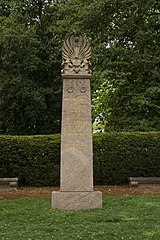
Taft is regarded as an average president but only because he was quite limited by Democrats and Progressives. His work as a Chief Justice is seen as much better. He was a man who ultimately had a passion on interpreting the law rather than enforcing it, annd he likely was not as great simply because the presidency was not his passion.
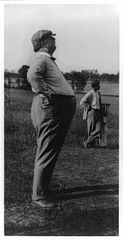
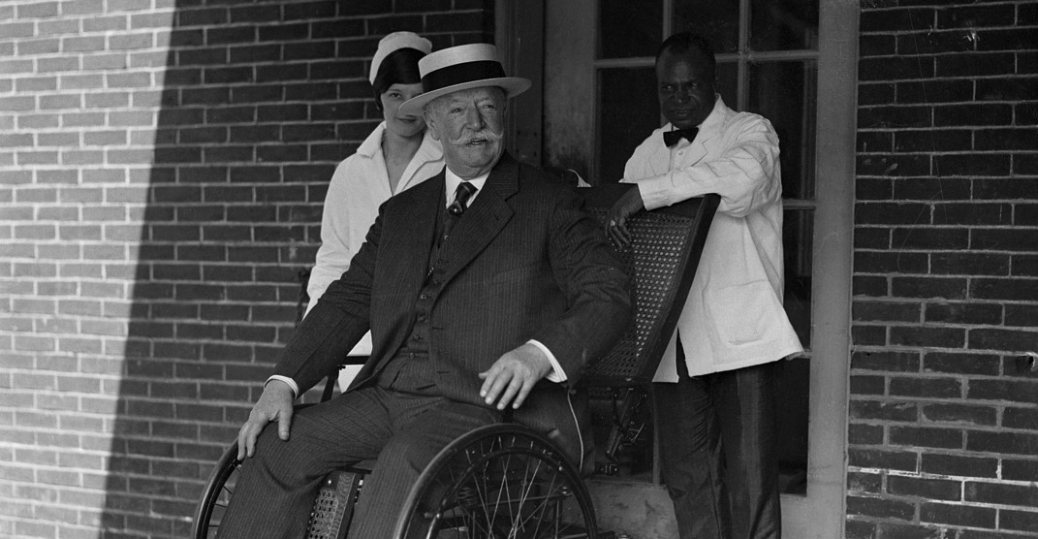
Left image: A picture of Taft golfing.
Right image: The last picture of Taft alive. Shows his weight loss after his presidency.
Taft in 1878 at Yale. No attribution available, from Wikimedia Commons.
Arlington National Cemetery, Public domain, via Wikimedia Commons
Johnston, Frances Benjamin, 1864-1952, photographer, CC0, via Wikimedia Commons
I could not find a correct copyright owner, found on this Reddit post but the title is only slightly true.
TheUSAPresidents.com
About Us Legal Political policy Reliability
Information on this site should not be plagiarized. This site is intended for hobby purposes, not commercial. Visit here for more information.